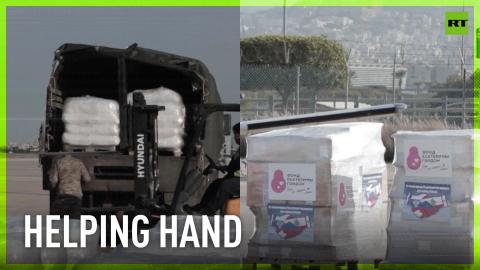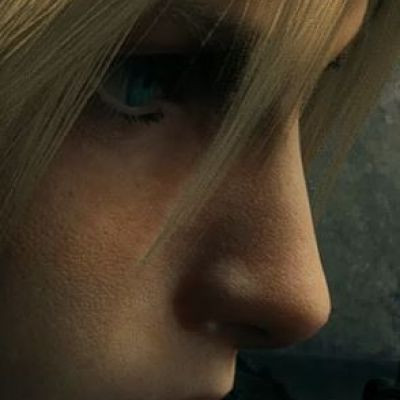Russia’s Giatsint-S self-propelled guns operate on the frontlines
1
0
27 Views
Published on 06 Mar 2023 / In
News & Politics
Crews of the 152-mm self-propelled ‘Giatsint-S’ guns carry out firing duties, striking artillery pieces and bunkers of the Ukrainian forces as the special military operation continues.
--------------------------------------------------------------------------------------
Freedom over censorship, truth over narrative.
Follow us on Facebook: https://www.facebook.com/RTnews
Follow us on Telegram: https://t.me/rtnews
Follow us on Twitter: https://twitter.com/RT_com
Show more
0



 RT
RT
 Stefan Molyneux
Stefan Molyneux






 Timcast IRL
Timcast IRL
 The Alex Jones Show
The Alex Jones Show



 Eggy Noggy
Eggy Noggy
 Redacted News
Redacted News


 TheQuartering
TheQuartering

 Better Bachelor
Better Bachelor

Log in to comment
Fyodor Fedorovich Petrov
Fedor Fedorovich Petrov was chief designer of the experimental design bureau of artillery weapons of factory number 9 (Sverdlovsk). The total number of adopted by the artillery systems of F.F. Petrov is 33, even the legendary designer V.G. Grabin is inferior to this indicator. According to their tactical and technical data, reliability and survivability, simplicity of the device and ease of use, all these guns met the requirements of the time and exceeded foreign analogues.
In the history of OKB-9, Fyodor Fedorovich Petrov occupies a special place - an outstanding domestic artillery weapon designer, Hero of Socialist Labor, Lenin’s laureate and four times USSR State Prize laureate, lieutenant general engineer, doctor of technical sciences, cavalier of three orders of Lenin, orders of the October Revolution, Suvorov II degree, Kutuzov I degree, the Red Banner of Labor and many medals.
Fedor Fedorovich was a man with an exceptional will in achieving his goal. His ideas and design thinking in the field of artillery systems wereinexhaustible, he showed an amazing ability and understanding of the goal that was set before him when creating artillery systems and weapons for tanks and self-propelled guns. It should be noted an important feature of his design activities. He paid special attention to the technological design, to the unification and standardization of units, and this led to the fact that several guns, completely different in firepower and combat use, had a common gun mount and recoil device.
Fedor Fedorovich Petrov was born in the village of Doktorovo now Venevsky district of the Tula region. The son of a village blacksmith. He began to work at age 15 as a worker on the railway. In 1922 - 1925 he served in the Red Army, during the period of service he entered the labor faculty [rabfak]. Since 1926 he studied at the Moscow Higher Technical School named after N.E.Bauman, and in 1930 with a group of students he was transferred to the artillery faculty of the Leningrad Engineering Institute (LMI), later the Leningrad Military Mechanical Institute (LMI), now the Baltic State Technical University ( BSTU). His teachers were teachers of the Military Technical Academy. F.E. Dzerzhinsky, such as D.E.Kozlovsky, I.I.Ivanov, Professor B.N.Okunev. In September 1931, exams and diploma defense took place at the Academy, the graduate of which F.F. Petrov always considered himself.
In 1931, after graduating from LMI, Fedor Petrov was sent to Perm at the Motovilikhinsky Artillery Plant No. 172, where he worked as the head of the technical bureau of the workshop, head of assembly, head of the mechanical section of the workshop. In 1934 he was transferred by the senior design engineer to the design bureau.
Since that time, the design activity of F.F.Petrov began, which lasted until the end of his life. From the first months of work in the production, which he was very proud of, his great determination, perseverance, perseverance in achieving his goals, enormous industriousness, good theoretical preparation - qualities that made it possible to achieve great success in creating the most advanced artillery pieces for his time were manifested.
In 1936 - 1937, the team of F.F. Petrov developed the 152-mm howitzer-gun of the 1937 model ML-20 (put into service with the Red Army), the 122-mm hull gun of the 1937 model A-19 (in service since 1939), 107 mm gun M-60.
A turning point in his design life - then a senior design engineer - was his participation in March 1937 in a meeting of the Council of Labor and Defense in the Kremlin with the participation of I.V. Stalin and K.E. Voroshilov, directors and chief designers of a number of leading artillery factories, at which F.F. Petrov presented his design proposals for creating the new 122mm divisional howitzer. To implement his proposal, an experimental design bureau was created on the basis of the Motovilikhinsky plant in Perm in 1938. Thanks to hard work in a short time, the famous 122-mm divisional howitzer of the 1938 model M-30 was created. It was decided to develop howitzers at once in three factories - Motovilikha, Uralmashzavod and plant No. 92. During the war years, the M-30 was the main striking power of the Red Army. These guns armed the artillery divisions and corps of the breakthrough of the High Command Reserve. The howitzer was produced until 1955, was in service with the Soviet Army until the mid-1970s, and in some countries of the world to this day. In total, more than 19,000 units were produced in the USSR.
In his memoirs, F.F. Petrov recalled: "The realization that the M-30 howitzer, with its service to its Motherland, justified all the hopes placed on it, acts warmingly and makes you forget all the unpleasant things associated with its formation as a formidable weapon for the enemy." And there were many difficulties with the creation and development of a new howitzer at three factories at once - at Motovilikha, Uralmashzavod and plant No. 92, where the M-30 was sharply, but not always justified, by V.G. Grabin.
A particularly unfavorable situation developed at Uralmashzavod. To rectify the situation and provide assistance, a commission of the Central Committee of the All-Union Communist Party of Bolsheviks arrived at the plant together with the leaders of the GAU and the NKVD. According to the results of its work, the plant management was replaced. To strengthen the staff (the old small artillery design bureau of the plant almost fell apart due to a series of unsuccessful works) and to more quickly resolve issues when setting up the M-30 series production in 1940, F.F.Petrov, A.N. Bulashev, N.G. Kostrulin were transferred to Uralmashzavod.
In 1940, Petrov was appointed head of the Uralmashzavod artillery design bureau in Sverdlovsk. From this time until 1974, the life of F.F. Petrov was inextricably linked with the plant number 9 and with the design bureau, which, despite its small number, during the years of World War II developed under his leadership eight adopted artillery systems: 152 mm D-1 howitzer, 85 mm, 100 mm and 122 mm guns for self-propelled guns, 122 mm and 152 mm self-propelled howitzers, 85 mm D-5T gun for T-34 and IS-1 and 122- tanks mm D-25T gun for tanks IS-2 and IS-3.
In 1942, the artillery production of Uralmashzavody was separated into a separate factory No. 9, it created an artillery experimental design bureau, whose chief designer was F.F. Petrov. During the Great Patriotic War, Design Bureau F.F. Petrova developed dozens of models and modifications of artillery systems. Of these, eight were adopted by the Red Army: 152-mm howitzer D-1; 85 mm, 100 mm and 122 mm guns for self-propelled guns; 122 mm and 152 mm self-propelled howitzers; 85 mm D-5T gun for T-34 and IS-1 tanks; 122-mm gun D-25T for tanks IS-2 and IS-3.
The wide unification and high adaptability of the main units, characteristic of F.F. Petrov’s guns, made it possible to organize their mass production as soon as possible and provide the front with the latest weapons, far superior to the similar weapons of all the fighting armies of other states.
For outstanding services in the field of creating new types of weapons, who raised the defensive power of the Soviet Union, by Decree of the Presidium of the Supreme Soviet of the USSR of January 5, 1944, Fedor Fedorovich Petrov was awarded the title Hero of Socialist Labor with the Golden Medal "Hammer and Sickle" and the Order of Lenin. By a resolution of the Council of People's Commissars of January 18, 1944, F.F. Petrov was awarded the military rank of "Major General of the Engineering and Artillery Service."
In the postwar period, under the leadership of F.F.Petrov created a 100-mm tank gun D10-T for the T-54 tank (1946), a 76-mm tank gun D-56TS for the floating tank PT-76 (1955), a 100-mm tank gun D-10T2S for the T-55 tank (1956), 85 mm D-70 gun for the light self-propelled gun SU-85 (1958), 115 mm 2A20 (U-5TS) tank gun for the T-62 tank (1961 ), 125 mm 2A26 tank gun for the T-64A tank (1968), 122-mm howitzer 2A31 for self-propelled gun 2C1 (1970), 152-mm howitzer 2A33 for self-propelled gun 2C3 (1971). In the post-war years, 85-mm anti-tank guns D-44 and D-48, self-propelled guns 57 mm SD-57 and 85 mm SD-44, 152 mm gun-howitzer D-20, 122 mm gun were put into service D-74, 122-mm howitzer D-30 (since 1961), howitzer D-30A (since 1979).
Most of the adopted domestic tanks (in particular the T-64, T-72, T-80, T-90) were equipped and equipped with 76, 100 and 125-mm guns developed by OKB-9 F.F. Petrov. According to their tactical and technical data, reliability and survivability, simplicity of the device and ease of use, all these guns met the requirements of the time and surpass foreign analogues. In addition, from 1955 to the end of the 60s, OKB-9, led by F.F. Petrov, was engaged in the design of missile systems for the Ground Forces, missile armament of modernized cruising submarines, anti-submarine missile systems "Blizzard".
Petrov was promoted to Lieutenant General Engineer (1966). Since 1974, F.F.Petrov was in leadership positions at the USSR Ministry of Defense Industry. In 1974, F.F.Petrov moved to Moscow, where he continued to work. In 1975, he retired.
He died on August 19, 1978.
He was buried at the Novodevichy cemetery in Moscow. Full member of the Academy of Artillery Sciences of the USSR (1946). Doctor of Technical Sciences (1947). Laureate of the Lenin Prize (1967) and four Stalin Prizes (1942, 1943, 1946 - twice). Member of the Supreme Soviet of the USSR in 1946-1950 and in 1954-1958. He was awarded three orders of Lenin, orders of the October Revolution, Kutuzov 1 degree, Suvorov 2 degrees, World War 1 degree, Red Banner of Labor, medals. In the city of Venev, Tula region, a monument-bust to F.F.Petrov was erected. In Motovilikhinsky district of Perm, a wonderful monument to the Hero is erected - on a high mountain on a pedestal there is a 122-mm howitzer M-30, which has returned from the front, the legendary creation of the designer. Since 1988, the name of Fedor Fedorovich Petrov has been OKB-9 in Sverdlovsk (now Yekaterinburg).
His associate designer V.A.Ilyin wrote about F.F.Petrov: "Petrov led the rearmament the entire Soviet Army, he had some special sense of smell, thanks to which he guessed what weapons should be created in order to get ahead of the development of technology."
I am surprised that with all the power they have on tap from the free to use idling engine that they are not engaging a high flow hydraulic pump to list the barrels up into firing position - very quickly - with some manual dialling in on the very fine settings - and then rapid lowering of the barrel...
Winding the barrel all the way up and then all the way down manually - is a terrible waste of valuable time - especially if the enemey can fire back almost straight away.
Even a high flow barrel drop, that basically allows the barrel to almost free fall for most of it's down travel and then automatically slow up for the last 1 meter and then slow slow right down for the last 20cm of barrel travel - so the barrel lands in it's rubber bearing pads like an egg in a foam mattress...
The barrel raising should be done in 4 or 5 seconds at the most.
The downwards traverse should be done in about 3 seconds..